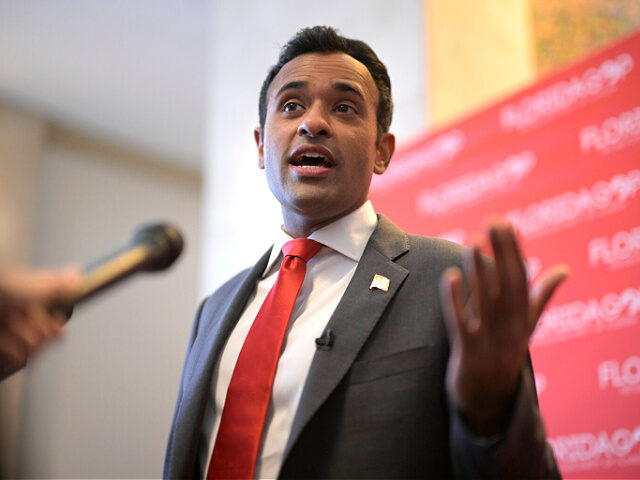Republican presidential candidate Vivek Ramaswamy is ditching television advertisements in favor of more direct and targeted means to reach voters, including phone calls, text messages, mail, and door-knocking.
Citing AdImpact and the campaign, NBC News first reported Tuesday of the campaign’s halt in television ad buys and embrace of what Ramaswamy campaign spokeswoman Tricia McLaughlin told the outlet was a strategy structured so the campaign “has the ability to be nimble and hypertargeted” in its ad spending.
The MSM is desperately trying to count me out. Don’t fall for their trick. We will shock the world on Jan 15. 🇺🇸
— Vivek Ramaswamy (@VivekGRamaswamy) December 27, 2023
Breitbart News spoke with Ramaswamy campaign CEO Ben Yoho on Wednesday night to discuss the strategy in-depth. Yoho emphasized that the funds that would have been used for television ads are simply being redirected to more targeted voter outreach initiatives.
“All we’ve done is reallocated the money we had budgeted for broadcast and cable to those higher [return-on-investment] tactics that we’ve found to get our voters out, which allows us to do a lot more of it because they are cheaper things, like addressable advertising is significantly cheaper than broadcast advertising,” Yoho said. “So we’re definitely using the data in that vein, but those cost savings, if you will, just allow us to do many more treatments, whether it be paid phones, paid doors, text messages, addressable ACR advertising, mail… we’re just quadrupling down on the folks that we’ve identified that are for Vivek, and we just need them to show up and do the damn thing on January 15.”
Yoho noted that the campaign would probably do some radio advertising before the Iowa caucuses, stating he believed “There’s a value there if done correctly.”
Presidential TV ad spending is idiotic, low-ROI & a trick that political consultants use to bamboozle candidates who suffer from low IQ.
We’re doing it differently. Spending $$ in a way that follows data…apparently a crazy idea in US politics.
Big surprise coming on Jan 15. 🇺🇸 https://t.co/i2X7Q5d2T9
— Vivek Ramaswamy (@VivekGRamaswamy) December 27, 2023
Later, he added, the campaign has “spent the last 11 months identifying the Vivek voter.”
“Some campaigns – well, I would say super PACs that are essentially the de facto campaign – running around bragging about, ‘We have 15,000, and we have 20,000 caucus commitment cards,’ and it’s like, what the hell does that really mean if the campaign can’t do anything with it? And are they real?” Yoho noted. “Well, we spent 11 months and Vivek’s investments and the small-dollar grassroots donations really putting data first and making sure we identified the right people, the people that are going to support Vivek, and we’ve used different tactics on bringing them along that journey, securing them, and getting them into a confidence bucket that we can turn out the vote.”
Moreover, he emphasized that many of the people who attend Ramaswamy’s campaign events are not registered voters.
“Now, if we were sitting here and looking at it today as like, ‘Oh, we’re only competing in this one small bucket of the likely Iowa caucusgoers that the state party provides to all the campaigns that everyone’s fighting over,’ it’s like, maybe that’s a little different strategy, but we weren’t naive on day one, and we went and built a coalition,” Yoho said. “And we know who those folks are. They’re there; the shock-the-world opportunity is there if we can get them to actually fulfill their commitment and show up at 7:00 p.m. on January 15. We’re going to spend every last resource we have in trying to do just that, and that is certainly much easier to do in a precision way than casting this wide net on broadcast.”
Thus far, candidates have spent a combined $93.8 million in television advertising alone in Iowa, Yoho pointed out, adding not much has changed in the contours of the field despite the exorbitant ad buys. Notably, former President Donald Trump remains the frontrunner by a significant margin over his opponents, but some minor movement has occurred among the rest of the pack, with Gov. Ron DeSantis (R-FL) falling substantially in the polls over the last year and former Gov. Nikki Haley (R-SC) seeing a modest surge in recent months.
Yoho contended that Haley’s rise is a result of the mainstream media providing her with steam rather than a benefit from television spending.
“It’s kind of bizarre, and you can even look at the money that is being spent on Nikki Haley,” he said. “I would argue that the advertising really didn’t do much for her; it was the propping up of mainstream media. The same money was spent before that is going into the final couple of weeks.”
“These folks like Nikki and Ron, they’re fighting this persuasion fight that they’ve been fighting for 11 months, and who are they persuading? How do they make up a 30-35 point deficit to the former president of the United States?” the Ramaswamy campaign chief asked. “If they haven’t done it in eleven months, they’re not going to do it the next two weeks.”
The move comes with the Iowa Caucuses and New Hampshire primary just weeks away. Ramaswamy’s polling average in Iowa on RealClearPolitics Wednesday showed him in fourth at 5.9 percent, as he sits behind Trump at 51.3 percent, DeSantis at 18.6 percent, and Haley at 16.1 percent.
In the RCP polling average in New Hampshire as of Wednesday night, Ramaswamy was in fifth place with six percent of support. Trump leads the way at 46.3 percent, followed by Haley at 24.8 percent. Former Gov. Chris Christie averages 10.5 percent, and DeSantis is behind him with 9.5 percent.

COMMENTS
Please let us know if you're having issues with commenting.